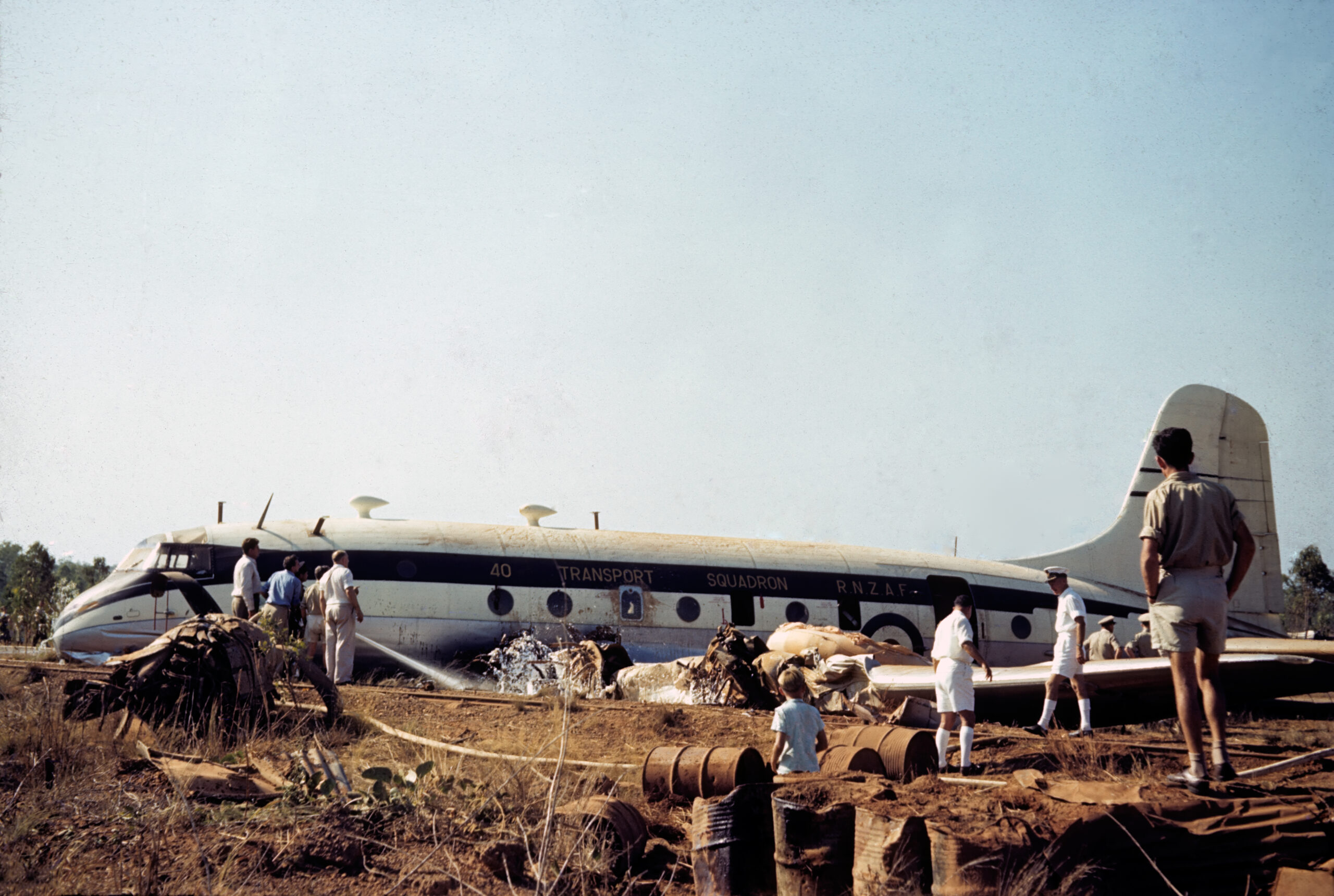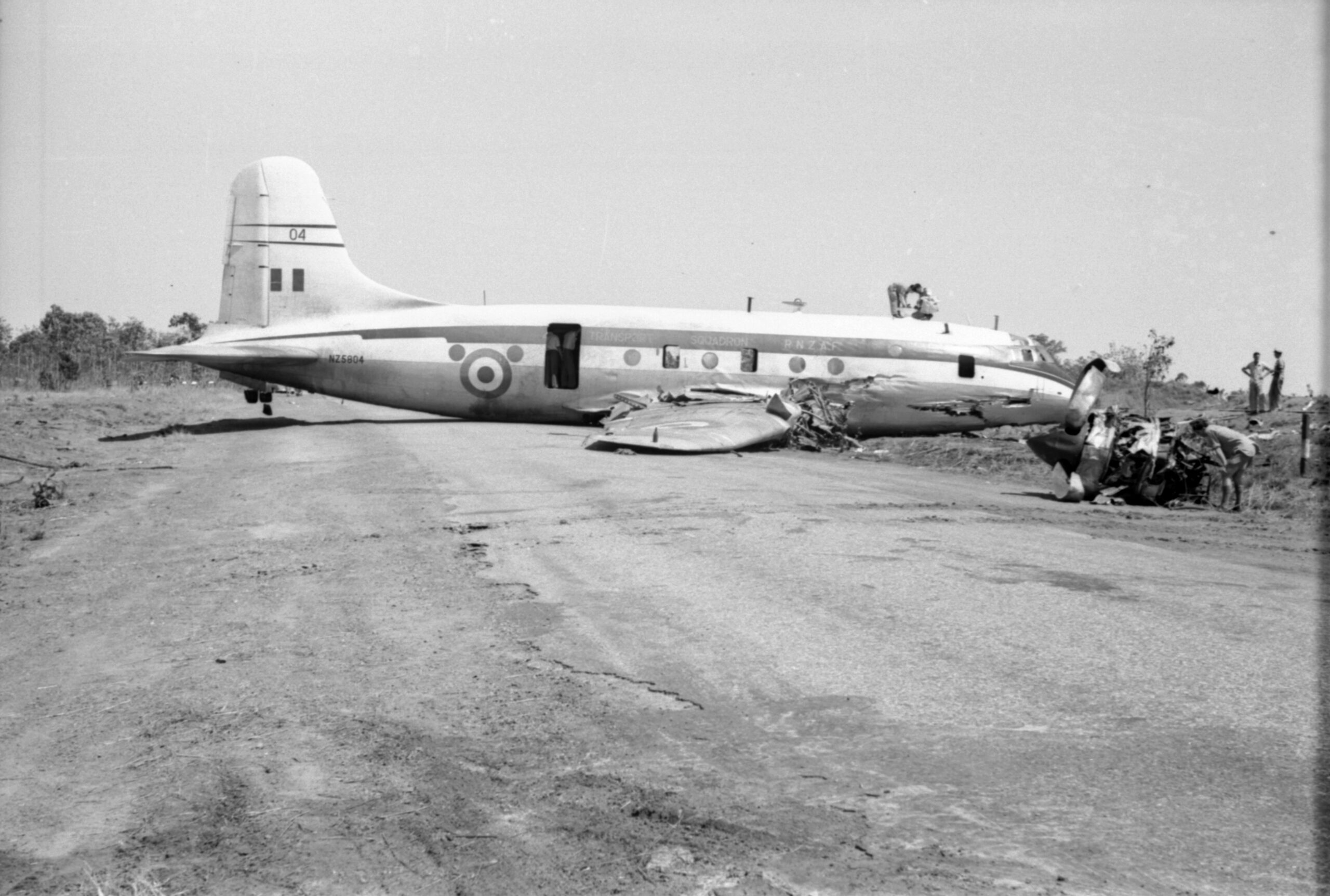There are a load of photos of that accident
here on the Wigram site. Here are a couple of examples.

2017-186 Image from the Grant Roberts personal collection.
No. 40 Squadron Hastings NZ5804 after crashing at Darwin after a bird strike.

WhG8883-55 No. 40 Squadron Hastings NZ5804 after crashing because of a bird strike at Darwin airport.
And here is a report from The Press, 10 September 1955
R.N.Z.A.F. PLANE CRASHESFlock Of Birds Hit At DarwinOCCUPANTS ESCAPE INJURY (N.Z. Press Association—Copyright) (Rec. 11.30 p.m.) DARWIN, Sept. 9.
The crew and passengers had an amazing escape when a Royal New Zealand Air Force Hastings bomber crashed after flying into a flock of birds while taking off from Darwin today. The plane crashed back on to the aerodrome when the birds put the four engines out of action.
With the pilot fighting for control, the aircraft swerved off the end of the strip, tore over a 15in water pipeline, ploughed over a 6ft railway embankment and swung around, coming to rest with its tail on a road and its nose against the train line.
Three of the plane’s motors were ripped out as it careered over the embankment. It is a total loss.
Of the nine passengers and crew of 10, only the captain of the plane. Squadron Leader K. B. Smith, was injured. He was treated for superficial head lacerations. The Hastings, of No. 40 R.N.Z.A.F. Transport Squadron, was returning from London and was heading for Brisbane. It was carrying the body of a New Zealand serviceman home for burial.
The aircraft left the hangar just after 9 a.m., but returned with what was believed to be trouble in one of the motors.
It took off at 9.20 a.m. and was airborne half-way down the 10,000 ft runway.
Engines Fail at 50ft
Eye-witnesses say the aircraft ran into a flock of kite hawks 50ft above the strip. The four engines cut out and with a screeching of brakes the aircraft touched down near the end of the strip. It then veered to the left, crashed through a fence and the water main and mounted the embankment. The aircraft turned almost completely around and came to a halt in a cloud of dust.
The passengers and crew jumped out through the back door and emergency exit hatches. The passengers included a woman.
Officials believe that only the rear-facing seating arrangements saved the passengers from serious injury. Fire engines reached the scene within a minute and sprayed foam on petrol leaking from one of the plane’s damaged tanks. A huge volume of water spurted from the main broken by the plane and Darwin’s water supply was reduced by half.
An inquiry into the accident will be held tomorrow. R.N.Z.A.F. officials, flying from Singapore, are due to arrive in Darwin tonight. This is only the second aircraft that No. 40 Squadron has lost since its formation early in the war. Its first casualty came after peace was signed —a Dakota returning with troops to New Zealand disappeared without trace off the New Hebrides.
The R.N.Z.A.F. acquired Hastings aircraft about four years ago. This is the first major mishap with any of them. They have flown many thousands of miles between New Zealand and Britain and other parts of the world. One of the aircraft was entered in the London-Christchurch air race, but was unsuccessful. Squadron Leader Smith was a member of the crew of that aircraft.
The names of the crew of the aircraft are as follows:—captain, Squadron Leader Smith; second pilot, Wing Commander L. H. Edwards; navigators, Flying Officer W. A. Devescove and Sergeant H. R. Hunt; signallers, Sergeant M. J. Stevenson and Sergeant T. K. McGregor; engineers, Flying Officer D. M. Stark and Sergeant J. M. Mclntyre; air quartermasters, Sergeant S. O’Byrne and Sergeant R. D. W. Tatten. Most of them are stationed at Whenuapai.
The names of the nine passengers are:—Mr J. A. Dale, chief fire officer of the Civil Aviation Administration, Wellington, Cadet Flight Sergeant P. J. Phillips, Cadet Flight Sergeant K. Gebbie, Lieutenant Higgs, Flight Lieutenant P. L. D. Cummins, an Air Department staff officer stationed at Ohakea, Flying Officer D. M. Crooks, Flying Officer J. M. Terry, Corporal W. F. Maugham, and W.A.A.F. Corporal M. Holmes, of Whenuapai.
Another Hastings aircraft will leave Whenuapai for Darwin tomorrow evening. It will pick up the stranded crew and passengers and return to New Zealand.



